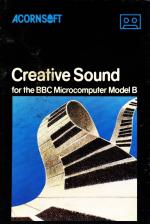
A&B Computing
 1st August 1985
1st August 1985
Categories: Review: Software
Publisher: Acornsoft
Machine: BBC Model B
Published in A&B Computing 2.08
Creative Sound
Creative Sound by Hybrid Technology's Chris Jordan and Music/Micro correspondent David Ellis is the latest in a long line of interesting musical releases for the BBC Microcomputer in the last six months.
In this book and book/disc/cassette package, we get the synthesis of Chris Jordan's expertise with the BBC (he designed the SOUND and ENVELOPE statements for the BBC and Hybrid produce the Music 500) and the writing and musical skills of David Ellis, well known for his columns in the music and computer press.
The style is chatty and humorous which helps break up the technical aspects. Some of the content is fairly demanding of the reader, especially without previous contact with either the music or microcomputer world.
If you want to know about the antecedants to the current technology, you will find an enthusiastic history at the start of Create Sound. And if you want to catch up on the latest in synthesiser/microcomputer combinations and the quite close links between the two, then the authors are just the people to keep you up to date.
Creative Sound is based on the BBC Microcomputer and the book is packed with listings, ranging from one line of SOUND statement to eight pages of synthesiser, or music compiler. The authors do well to avoid the constant repeats of the User Guide on SOUND and ENVELOPE but satisfy our curiosity with constructive examples. There is as much to see on screen in the way of Fourier synthesis and SOUND and ENVELOPE demonstrations (very nicely programmed and presented) as there is music to listen to. The text has plenty of diagrams and screenshots and information on program use.
The authors' interest in music rather than noise is demonstrated by a very short acknowledgement of games noises and sound effects. From there it's on to real time music, a mini studio for record, edit and playback, a preset, programmable and echo synthesiser and a programmable sequencer.
The two main chapters of interest to already accomplished micro musicians will be those on composing by computer and composing with the assistance of the computer. Mozart's musical dice game with which he composed waltzes is reproduced for the micro. It makes fascinating listening and is followed by investigations into minor chords and fractal tune generation. Composing by statistics always seems a bit cold and the authors appropriately fill in the academic background to work in this field. You'll be delighted to know that this chapter closes with a program for composing coloured music and the self-fulfilling Muse.
The computer assisted composition revolves around the idea of a MCL (Music Composition Language). From an earlier music interpreter and forays into Canons and Phase Music (which necessitates some complex reconfiguring of the O.S. sound software), emerges a music compiler. An easy to use combination of keyboard characters form the composition codes (AMPLE programmers will be on familiar ground) which are compiled into an efficient (two byte per not) intermediate code for interpretation and playing.
The music, original or copied from sheet music, is entered into DATA statements and can easily be *EXECed onto the end of the main program. Various examples are provided, from Bach to the ear piercing Continuum by contemporary Hungarian composer, Gyorgi Ligeti. The compiler is not just a digital jukebox however. It forms with the rest of the programs in Creative Sound a formidable musical toolbox for the experimenter. The programming is to a high standard in its own right and not just throwaway illustration of the text content.
The authors finish off Creative Sound with the least creative section but nevertheless a useful look at musical education software aids. Taking their cue once again from the superpower examples from America, the authors produce some humble BASIC listings for pitch training, pitch tuning, interval drill, keyspinner (minor or major keys?), key confuser, scale recognition and rhythm drill. All should prove useful to the teacher of music or the individual inspired to gain some conventional music skills at the same time as working on his first AMPLE concerto!
For anyone already bitten by the music bug Creative Sound is essential reader and programming. For anyone teetering on the brink, £9.95 is not a lot to pay for a good informative read, some valuable programs and music to show off with! If you enjoy the luxury of being more into music than programming then the £17.95 (book plus cassette) or £19.95 (book plus discs) is a worthwhile investment, just so that you can get your hands on the working programs that much quicker.
An early pioneer of computer music, Max Mathews, is quoted in Creative Sound: "Computers will add a new dimension to music, especially the home computer. It will be sufficiently easier to play that many people who otherwise could only listen to music will become active musicians. This may be the biggest accomplishment of the home computer market." Dave Ellis and Chris Jordan are doing their bit to make this prediction come true.
Scores
BBC Model B Version| Overall | 88% |


